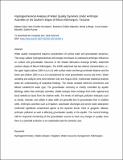| dc.contributor.author | Said, Mateso | |
| dc.contributor.author | Komakech, Hans | |
| dc.contributor.author | Mjemah, Ibrahimu | |
| dc.contributor.author | Lufingo, Mesia | |
| dc.contributor.author | Munishi, Linus | |
| dc.contributor.author | Kumar, Sudhir | |
| dc.date.accessioned | 2023-10-04T11:18:28Z | |
| dc.date.available | 2023-10-04T11:18:28Z | |
| dc.date.issued | 2022-07-14 | |
| dc.identifier.uri | https://doi.org/10.1007/s42250-022-00419-z | |
| dc.identifier.uri | https://dspace.nm-aist.ac.tz/handle/20.500.12479/2112 | |
| dc.description | This research article was published in the Chemistry Africa volume 5, pages 1589–1610 (2022) | en_US |
| dc.description.abstract | Water quality management requires consideration of surface water and groundwater dynamics. This study utilizes hydrogeochemical and isotopic techniques to understand anthropic influences on surface and groundwater resources in the Kikafu–Weruweru–Karanga (KWK) watershed southern slopes of Mount Kilimanjaro. The KWK watershed had two distinct characteristics, i.e., the upper region (above 1000 m.a.m.s.l) with surface water and few groundwater features and the lower part (below 1000 m.a.m.s.l) characterized by most groundwater sources and rivers. Water sampling and analysis were done between July and August 2019; multivariate statistical analysis aided the understanding of analytical findings. The results revealed NaHCO3 enrichment and Mixed CaNaHCO3 water type. The groundwater chemistry is chiefly controlled by aquifer lithology rather than anthropic activities. Stable isotopes show recharge from both regional and local rainfall as traced from the shallow wells. The levels of anthropic pollution indicators such as nitrate, chloride, and sulfate in deep wells are generally low in groundwater than in shallow wells. Anthropic activities such as irrigation, wastewater discharges and severe water abstraction confirmed significant contaminant agents at the dynamic levels. Next to geogenic releases, anthropic pollution as well is affecting groundwater quality in the aquifer. The current findings call for improved monitoring of the groundwater sources to track any changes in quality since there is a potential evolution to an undesirable state for domestic uses. | en_US |
| dc.language.iso | en_US | en_US |
| dc.publisher | Springer Nature | en_US |
| dc.subject | Hydrogeochemistry | en_US |
| dc.subject | Stable isotopes | en_US |
| dc.subject | Irrigation | en_US |
| dc.subject | Water resources management | en_US |
| dc.title | Hydrogeochemical Analysis of Water Quality Dynamics Under Anthropic Activities on the Southern Slopes of Mount Kilimanjaro, Tanzania | en_US |
| dc.type | Article | en_US |

